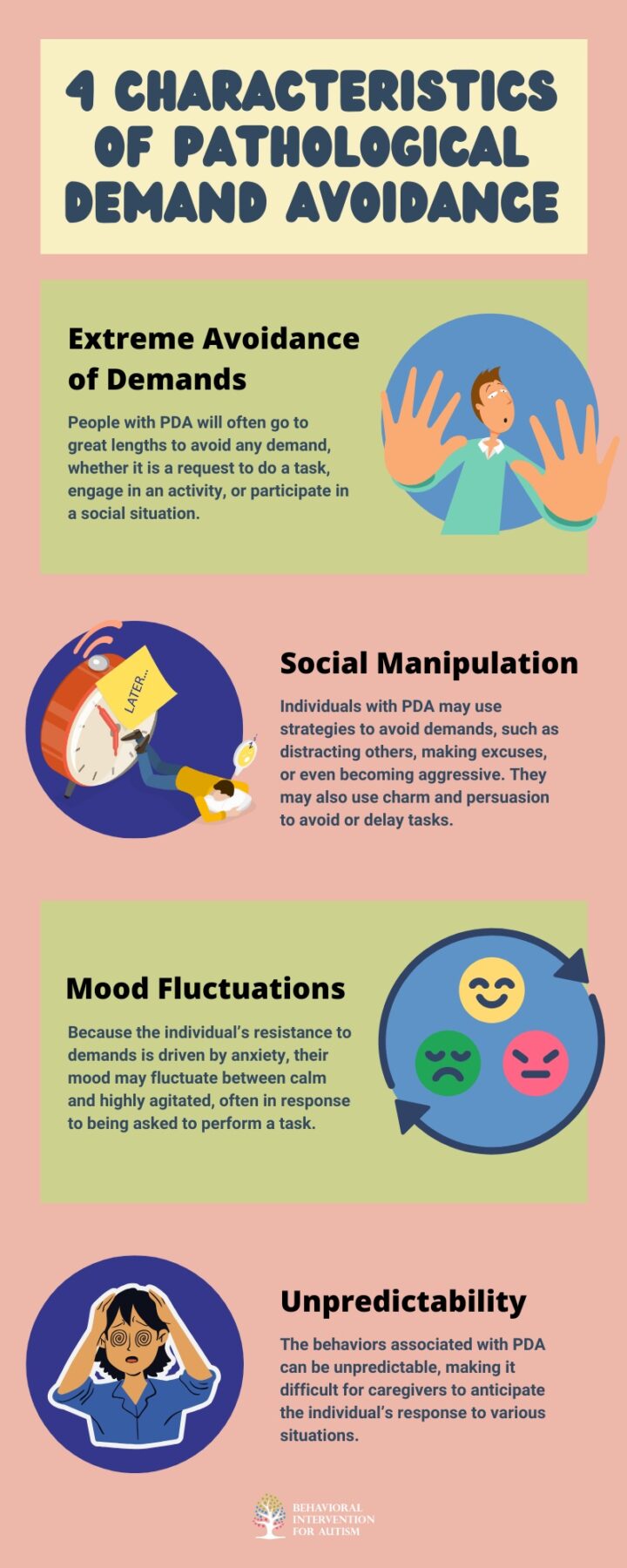
Table of Contents
Pathological Demand Avoidance (PDA) is a complex condition that is often associated with Autism Spectrum Disorder (ASD). It describes a pattern of behavior in which individuals exhibit extreme resistance to everyday demands and expectations, even when those demands are relatively simple or routine. PDA is sometimes considered a subtype of autism, though its recognition and understanding vary within the medical and therapeutic communities.
People with PDA may experience heightened anxiety and fear when faced with demands, leading them to avoid, resist, or challenge the request in various ways. These behaviors can be disruptive and confusing to both caregivers and professionals, but understanding PDA is key to providing effective support, including tailored approaches such as ABA therapy, and creating an environment where the individual can thrive.
In this article, we will explore the characteristics of PDA, how it manifests in individuals with autism, common signs and symptoms, strategies for managing it, and how it differs from other autism-related behaviors.
What Is Pathological Demand Avoidance?
Pathological Demand Avoidance (PDA) refers to a behavioral condition characterized by an individual’s overwhelming desire to avoid or resist any perceived demands or expectations placed upon them. This can include demands to do tasks, follow instructions, or even engage in social interactions. The resistance is often disproportionate to the actual difficulty of the request, and the individual may resort to a range of strategies to avoid complying.
People with PDA are often seen as defiant or difficult to manage because they consistently reject requests, even if those requests are simple or benign. However, the avoidance behavior is not simply a matter of being oppositional or non-compliant; it is typically driven by underlying anxiety, which can lead to emotional distress. This makes the behavior particularly challenging for caregivers and educators to manage, as traditional disciplinary strategies may not be effective.
Characteristics of Pathological Demand Avoidance
PDA is most commonly seen in individuals with autism, though it is also observed in some individuals without autism. Key characteristics include:

4 Signs and Symptoms of Pathological Demand Avoidance
Understanding the signs and symptoms of PDA is crucial in recognizing and diagnosing the condition. While every individual with PDA is unique, there are some common behaviors and characteristics to look out for.
1. Resistance to Requests
The hallmark of PDA is an extreme resistance to any perceived demand, whether it’s an instruction, request, or expectation. This resistance can be expressed in several ways, including:
- Deflection: The individual may distract others with irrelevant topics, jokes, or actions in an attempt to avoid the demand.
- Refusal: They may outright refuse to do something, regardless of how simple the task may be.
- Delays: They might delay or stall when asked to do something, hoping that the demand will go away on its own.
2. Social Manipulation and Control
One of the distinguishing features of PDA is the individual’s use of social strategies to manipulate the situation. These behaviors can include:
- Charm: The individual may use charm to get others to comply with their wishes, often bypassing demands entirely.
- Excuses: They may come up with creative excuses to avoid tasks, such as claiming they are tired, ill, or unable to do the task.
- Playing the Victim: Some individuals with PDA may try to manipulate others by portraying themselves as victims, using emotional outbursts or expressions of distress to avoid demands.
3. Mood Swings and Emotional Regulation
People with PDA often experience significant mood swings, particularly in response to stress or demands. These mood changes can include:
- Anxiety: Anticipating demands can trigger high levels of anxiety, leading to avoidance behavior.
- Irritability: When unable to avoid a demand, individuals with PDA may become irritable or aggressive.
- Depression: Prolonged stress and resistance can lead to feelings of frustration or sadness, contributing to mood fluctuations.
4. Sensory Sensitivity
Many individuals with PDA also have heightened sensory sensitivities, which can contribute to their resistance to demands. For example, loud noises, bright lights, or certain textures may cause them to become overwhelmed or anxious, leading to avoidance behaviors.
How PDA Differs from Other Autism-Related Behaviors
While PDA shares some similarities with other behaviors associated with autism, such as social difficulties and sensory sensitivities, it is distinct in several important ways. Understanding these differences is crucial for providing appropriate support.
PDA vs. Typical Autism Behavior
- Demand Avoidance vs. Routine Resistance: Many individuals with autism struggle with changes in routine or new demands, but PDA is characterized by an extreme and pervasive avoidance of all demands, regardless of the situation.
- Behavioral Strategies: In typical autism behaviors, individuals may show frustration or meltdown when demands are placed on them, but PDA involves more calculated avoidance strategies, such as manipulation or deflection.
PDA vs. Oppositional Defiant Disorder (ODD)
- PDA and ODD: While both conditions involve defiant behavior, ODD is generally seen as a pattern of oppositional behavior toward authority figures, while PDA is driven by an intense desire to avoid perceived demands in all areas of life, often regardless of authority.
4 Strategies for Managing Pathological Demand Avoidance
Managing PDA can be challenging, but there are several strategies that can help individuals with PDA manage their behaviors and reduce stress for caregivers and educators.
1. Reducing Anxiety
Since anxiety is often the underlying cause of demand avoidance, it is crucial to address it. Strategies to reduce anxiety include:
- Visual Schedules: Providing a clear, visual schedule can help individuals with PDA feel more in control and reduce anxiety about what is expected of them.
- Predictability: Establishing routines and making transitions predictable can help alleviate stress and prevent avoidance behavior.
- Calming Techniques: Teaching relaxation techniques, such as deep breathing or mindfulness, can help individuals regulate their anxiety.
2. Flexibility in Approach
It’s important to be flexible in how demands are presented. Instead of giving direct orders, which can trigger resistance, try offering choices or framing requests in a way that gives the individual some control. For example:
- Offer Choices: Instead of saying, “You need to do your homework now,” you could ask, “Would you like to start your homework now or after a break?”
- Use Collaborative Language: Phrasing demands in a collaborative way, such as “Let’s work together on this,” can help reduce the feeling of pressure.
3. Positive Reinforcement
Using positive reinforcement can encourage compliance without triggering resistance. Rewarding small steps toward a demand, rather than insisting on full compliance, can help build trust and motivation. Reinforcements can include:
- Praise: Acknowledge and praise efforts, even if they fall short of the desired outcome.
- Preferred Activities: Allowing access to preferred activities or sensory breaks as rewards can motivate individuals with PDA to engage in tasks.
4. Avoiding Power Struggles
Power struggles are a common pitfall when managing PDA. It’s important to avoid escalating situations by remaining calm and not engaging in direct conflict. Instead:
- Stay Calm: When resistance occurs, try to remain calm and patient.
- Use Redirection: If the individual is resistant to a task, try redirecting their attention to something else that is less stressful.
Pathological Demand Avoidance (PDA) presents unique challenges for those with autism, their families, and their educators. It’s essential to understand that PDA is driven by anxiety and that traditional methods of managing autism-related behaviors may not be effective. By adopting a flexible, compassionate approach that reduces anxiety, provides structure, and offers choices, caregivers and educators can better support individuals with PDA and help them navigate daily demands.
Take Action Today for Better Support
If you’re noticing signs of Pathological Demand Avoidance (PDA) in your child or loved one, it’s essential to seek support from professionals who truly understand. Our team at Behavioral Intervention for Autism specializes in ABA therapy in Florida, designed to help manage behaviors and foster growth. We are dedicated to providing individualized care that supports each client’s unique needs, offering expert guidance every step of the way. Reach out to us today to learn how we can help you create a positive path forward. Together, we can work towards meaningful improvements in your child’s life.
- 9 Common Obsessions of Children With Autism You Should Know - February 25, 2025
- What is Neurodiversity? A Guide to Embracing Differences - February 25, 2025
- Understanding Hyperfocus in Autism: What It Means and Why It Happens - February 25, 2025

